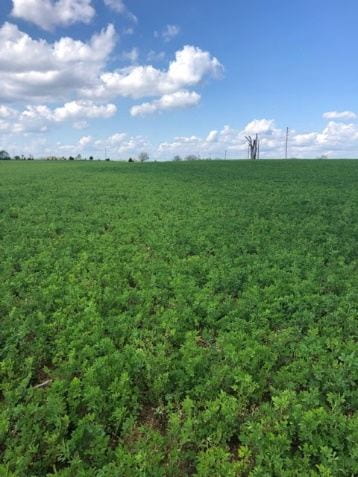Darsy Smith, Graduate Student & Dr. William Lamp, Professor
University of Maryland, Department of Entomology

An unexpected outbreak of cowpea aphid, Aphid craccivora Koch, in Maryland was discovered last month by Terry Patton, who was contacted by Russell Griffith, tractor operator leader at Beltsville Agricultural Research Center (BARC), because of the yellow appearance of an alfalfa field (Figure 1) and the infestation of dark aphids (Figure 4). Since the 1990s, infestations of the cowpea aphid have been observed in Maryland alfalfa, but this is an unusually large outbreak. Stay alert to this emerging pest and learn how to identify it since it has a wide range of hosts and may damage crops.


Cowpea aphid identification and injury. Cowpea aphid is not generally an economic pest in alfalfa but learning how to identify the aphid and its injury can help you prevent losses. Cowpea aphid is easily differentiated from other aphids in alfalfa because its dark coloration, with the abdomen of the adults much darker and shinier than the rest of its body (Figure 2). In addition, the cornicle (or siphuncule) is dark and long (Figure 2). The nymph is less shiny (opaque) and varies from brown to gray (Figure 3). The legs and antennae of both adults and nymphs are pale with dark tips (this characteristic is more distinctive in adults).
The cowpea aphid is a sap-sucking feeder and damage caused in alfalfa by this pest results from the injection of a toxin into the phloem of the plant. With high population densities on plants, the aphid can cause stunting or plant death. In addition, it can cause yellowing in alfalfa leaves (Figure 1). Like other aphids, this insect produces honeydew that will benefit fungus growth and eventually cause sooty mold.
How to find them? Cowpea aphids are usually found in clusters on the alfalfa leaf and stems (Figure 4). It can also be found in vegetative growth and flower parts of a wide range of hosts. They are readily sampled with sweep nets.

Host plants. Cowpea aphid is most commonly found in alfalfa, but may be found on other legumes, such as clovers. More uncommonly, the aphids occur on a variety of weeds and other plants in other plant families.
Management options. Unfortunately, there is not an economic threshold specified for this pest in Maryland alfalfa at this point. However, here are general guidelines for responding to the pest:
- Conserve natural enemies. Natural enemies such as lady beetles, damsel bugs, and parasitoid wasps often locate, feed, and reproduce in conjunction with high densities of aphid in alfalfa. If you conserve natural enemies you might find aphids parasitized by parasitoid wasps (Figure 5). When scouting for aphids, watch for natural enemies to help control aphid populations. To help natural enemies stay in your alfalfa field you can use border-strip cutting while harvesting to provide refuge habitats. For more information of this practice, see “Harvest Scheduling and Harvest Impacts on IPM” at the end of this report.
- Monitoring for decision-making. Early infestations in alfalfa can result from migration from southern areas. Pay attention to alfalfa fields in March and continue to monitor until fall. Since there are no thresholds developed for cowpea aphid, the thresholds for insecticide applications developed for the blue alfalfa aphid can be used: if alfalfa is 10 inches, then treat if there are 20 or more aphids per stem; if alfalfa is 20 inches tall, then treat if 50 or more aphids per stem.

Figure 5. Aphids parasitized or aphid mummies by a parasitoid wasp. Note the emergence hole (yellow arrows) of the parasitoid wasp in the mummy. Photo courtesy of Darsy Smith.
Potential reasons for the outbreak.
Researchers in the Lamp Lab, University of Maryland, have noted this pest in greenhouse settings but rarely observed them in alfalfa fields. Dr. Lamp suggests that the cowpea aphid may have migrated into Maryland because this species is more common in southern and western areas. Also, the mild winter may have allowed individuals that migrated last year to overwinter in Maryland. Additionally, lack of natural enemies in early spring can potentially lead to an outbreak. Conserving the natural enemies in alfalfa fields and neighboring areas can help decrease aphid abundance.
How can you help?
Records from your alfalfa fields and surrounding crops are valuable sources of information. The information is helpful to not just explain an outbreak but also to provide useful guidelines for farmers to manage the crop and avoid a future outbreak. Practical information that you can provide include any of the following:
- Date of first time you have observed the pest
- Date of outbreak
- Plant height and phenology stage: when you observed the pest for the first time and during outbreak
- Presence of natural enemies
- Pesticide use and efficacy of application
- Alfalfa cultivars/varieties planted during outbreak and previous year
- Pictures of damage and estimate of loss
If you find cowpea aphid in your alfalfa field, please contact the nearest county extension office.
Further resources:
University of California Pest Management Guidelines: Alfalfa, Cowpea aphid. http://ipm.ucanr.edu/PMG/r1301511.html
University of California Pest Management Guidelines: Alfalfa, Blue alfalfa aphid http://ipm.ucanr.edu/PMG/r1302311.html
University of California Pest Management Guidelines: Alfalfa, Harvest Scheduling and Harvest Impacts on IPM. http://ipm.ucanr.edu/PMG/r1901011.html#BORDERSTRIP
Aphids on the world’s crops. An identification and information guide. http://www.aphidsonworldsplants.info/
Prepared by Darsy Smith, Graduate Student, Department of Entomology, University of Maryland
